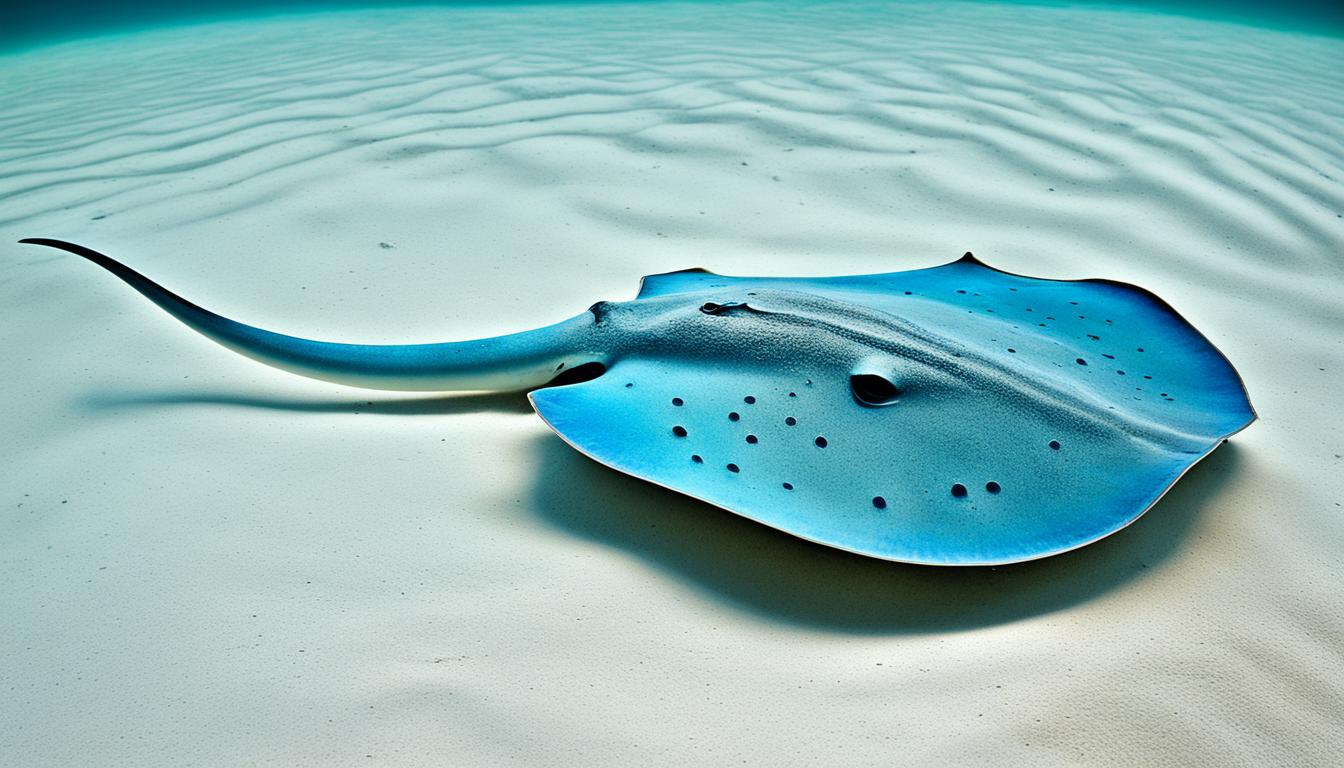Stingrays have different lifespans depending on the species. Their life cycles and biology are quite interesting. For example, Southern stingrays live longer than many others. This article will explore how long stingrays live and the challenges they face.
Stingrays face many challenges in the wild and with humans. We will look into their life in the ocean and how they interact with us.
Understanding Stingray Lifespan
The lifespan of stingrays varies a lot among different species. It’s affected by many factors. Knowing how long stingrays live helps us understand their biology and how they fit into their environment. Some stingrays can live more than 15 years, while others live shorter lives. The environment is key to how long they live.
The stingray aging process starts from being a young one. Young stingrays face many dangers, like being eaten and changes in their home. How well they adapt to their home affects their health and how long they live. For example, the Southern stingray does well in areas full of seagrass, which helps it survive.
Here’s a table that shows how long different stingray species live:
| Stingray Species | Estimated Lifespan (Years) |
|---|---|
| Southern Stingray | 15-25 |
| Spotted Eagle Ray | 10-15 |
| Common Stingray | 15+ |
| Cownose Ray | 10-12 |
How long do stingrays live?
The lifespan of stingrays varies a lot among species. It can be affected by many factors. Knowing these differences helps us understand their biology and behavior better.
Average Lifespan of Southern Stingrays
Southern stingrays can live up to 15 years on average. Their lifespan depends on things like their environment, predators, and other factors. These stingrays are known for being resilient and adaptable. These traits help them live longer.
Longevity Among Different Stingray Species
Stingray longevity changes with different species. Some may live just a few years in bad conditions. Others can live over 20 years in good environments. Their lifespan is often affected by their habitat and food supply. Some species can even live longer than average, showing how adaptable these creatures are.

Factors Affecting Stingray Longevity
Understanding what affects stingray longevity helps us see how they survive in different places. Many things play a part in their lifespan and health.
Environmental Conditions and Habitat
Environmental factors are key to the stingrays’ living spaces. Things like water temperature, salt levels, and oxygen affect their growth and health. For example, good conditions can help them reproduce more, while bad ones can stress them out and shorten their lives. A healthy home means stingrays are more likely to live longer.
Predation and Survival Rates
Predators are a big threat to stingrays. Sharks and other big fish can be a danger. Humans also harm them by destroying their homes and overfishing. Southern stingrays can hide in the sand to protect themselves. This helps them avoid predators and live longer in the wild.
The Stingray Aging Process
The aging process of stingrays is quite fascinating. It shows how their biology affects their lifespan and how they reproduce. As stingrays grow, they change physically in ways that affect their ability to reproduce and their life cycle.
Physical Changes Over Time
Stingrays change physically as they get older. These changes include:
- Increased Body Size: Stingrays get bigger as they age, which changes how they move and act.
- Development of Reproductive Organs: The growth of testes in males and ovaries in females shows they can reproduce.
- Skin Texture Alteration: Older stingrays have thicker skin, helping them adapt to their surroundings.
Knowing about these changes helps us understand how stingrays age. These changes are important for their ability to reproduce and survive.
Reproductive Maturity and Lifespan Correlation
Reproductive maturity is different for male and female stingrays. Males become ready to reproduce at about 2 years old, while females are ready later. This affects how long stingrays live together in groups. The way different species reproduce also depends on their habitat and how long they live, which helps guide conservation efforts.
Stingray Mortality Rate in the Wild
The stingray mortality rate in the wild is influenced by many ecological factors. Predators and diseases are big threats. These threats affect how long stingrays can live in the wild.
Things like pollution and climate change also play a big part. For example, dirty water can make it hard for stingrays to find food and makes them more likely to get sick. This can greatly increase the stingray death rate. Conservation efforts try to fight these environmental issues.
Knowing about stingray death rates helps us understand their health and how to help them. By studying these rates, we learn how tough stingrays are and what helps them live longer in different places.
FAQ
How long do stingrays live?
Stingrays can live up to 15 years, depending on the species. The Southern stingray is known to live this long in good conditions. Other stingrays may live from a few years to over 20 years, based on their environment.
What factors influence stingray longevity?
Many things affect how long stingrays live, like water temperature, salt levels, and their living space. Being eaten by predators and human activities also play big roles in their life span and survival.
Do different species of stingrays have different lifespans?
Yes, stingrays of different kinds live different lengths of time. For instance, the Southern stingray can live up to 15 years. But, some stingrays in safe places can live over 20 years. Others might only live a few years in harsher conditions.
What is the stingray aging process?
As stingrays get older, they change physically, which affects how they reproduce. Males become ready to reproduce at about age 2. Females may take longer, which is important for understanding their numbers.
How does predation affect stingray survival rates?
Being eaten by other animals is a big threat to stingrays. Southern stingrays have to avoid sharks and humans to survive. They can hide in the sand to stay safe.
What is the stingray mortality rate in the wild?
In the wild, stingrays face many dangers like being eaten, getting sick, and losing their homes. Things like pollution and climate change also make their lives shorter.







